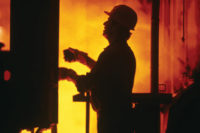
In spite of the enormous physiological stress heat places on the body, physical activity in hot environments is unavoidable for many workers. Heat-related stress increases the risk of illness, leads to decreased productivity, and tragically, continues to claim the lives of workers and athletes.
The common denominator in these deaths is hyperthermia — dangerously high body temperature that incapacitates and kills. The good news is, hyperthermia is both preventable and treatable. Managing risk factors, educating your workforce and responding quickly to emergencies all contribute to saving lives.
Heat reduces work output and increases risk
There are three reasons heat exposure makes work more difficult:
1. Heat negatively affects mood and mental functioning, leading to an increase in unsafe behaviors, poor decisions, worksite accidents and injuries.
2. When exposed to heat, the body has to redirect blood from internal organs and muscles to the skin to help shed heat to the external environment. That alteration in blood flow can mean a drop in blood pressure leading to lightheadedness and fainting.
3. Humans sweat in response to heat, and that loss of fluid makes it even more difficult to maintain normal physiological functions. Sweating helps in cooling only if it evaporates from the skin, and this is a problem in humid environments or when evaporation is restricted by clothing or equipment that typically doesn’t “breathe.” Sweating can quickly lead to dehydration and an increase in body temperature, a physiological double-whammy. The risk of heat illness skyrockets when workers are dehydrated, have abused alcohol or drugs, are ill, obese, unaccustomed to heat or unfit.
When all else fails — drink fluids
A hot body can lose heat in only four ways.
Heat can be conducted directly from the body to a cooler object, such as when a cold beverage can is pressed against the forehead. As good as that might feel, the actual amount of heat loss via conduction is usually quite small.
Convective heat loss — the “wind-chill” factor — can be a great aid to cooling under the right circumstances. For example, circulating cool air around hot workers creates a microenvironment that encourages heat loss. Unfortunately, a cool work environment is more often the exception than the rule at many worksites.
Because of the limitations of conductive, convective, and radiative heat loss, workers in hot environments have to rely on the fourth way — evaporation of sweat from the surface of the skin.
Sweat rates can easily exceed one liter/quart per hour during work in the heat — some individuals can lose over two liters per hour. If workers do not drink sufficient volumes of fluid to replace lost sweat, blood volume progressively declines, making it increasingly difficult to meet the competing demands of muscles, skin, and other organs for an ever-diminishing volume of blood. Serious physiological penalties including increased heart rate, reduced cardiac output, reduced blood flow to muscles and higher core temperature accompany even a small amount of dehydration. Remaining well hydrated during work in the heat reduces the overall physiological strain and improves mental and physical performance.
Lessons from the football field
Both authors have spoken to NFL teams about the health- and performance-related challenges of working hard in the heat. During summer pre-season training camps, players push themselves hard during twoa- day practice sessions. The best coaches recognize that a hot environment places limits on their team’s capacity to work hard, and so they alter practice protocols accordingly. Players take breaks more frequently and are encouraged to remove jerseys, pads, and helmets whenever possible. There are constant reminders to hydrate and take advantage of the shade, cool breezes or cooling fans to assist in convective heat loss. Practice and game clothing are carefully chosen, favoring fabrics that wick away sweat and facilitate evaporative cooling. Coaches help their players by restructuring portions of practice in ways that accomplish team goals and reduce the overall risk of heat illness.
The following tips used by NFL players to stay cool, safe, and productive can be modified to apply to any worksite:
Stay cool
- The cooler you stay, the harder you play — or work.
- Take advantage of the wind and shade to increase heat loss.
- Find a cool place to rest whenever possible.
- Remove extra clothing and equipment during breaks.
- Wear garments designed to release moisture — evaporation = cooling.
- Consume at least 16 – 32 ounces of beverages during breakfast.
- When sweat rates are high, don’t rely on thirst. Drink on a regular schedule.
- Use meal times to rehydrate.
- Limit alcohol consumption during the work week. Alcohol is a diuretic that makes it difficult to start the job well hydrated.
- Watch urine color. Urine the color of apple juice usually indicates dehydration.
- Monitor body weight before and after work. Weight loss exceeding a couple pounds indicates the need to increase fluid intake.
- Monitor meds. Some prescription medications can increase the risk of heat illness. For example, antihistamines and anticholinergic drugs reduce sweat production. Beta-adrenergic and calciumchannel blockers interfere with skin blood flow. Amphetamines and tricyclic antidepressants increase heat production.
- Know the warning signs of dehydration and heat illness: headache, lightheadedness, dizziness, unusual fatigue, irritability, confusion, nausea, vomiting, cramping, diarrhea.
- Speak up if you don’t feel normal. Even the toughest, most experienced worker can be quickly overwhelmed by the heat. Taking precautionary measures is the best way to preserve lives and productivity. This is particularly true when workers return to the job from a bout of illness.


